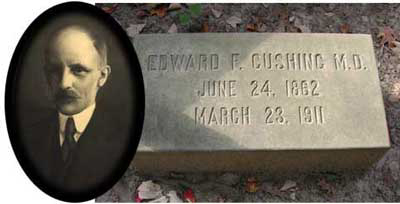Dudley Peter Allen (1852-1915)
 Allen was a surgeon, a professor of surgery and one of the founders of the Cleveland Medical Library Foundation. Born in Kinsman, Ohio, son of Dudley Allen, grandson of Peter Allen, both physicians. He did his undergraduate work at Oberlin and earned his medical degree from Harvard, he also studied advanced surgical techniques and bacteriology in Europe, returning to Cleveland in 1881.
Allen was a surgeon, a professor of surgery and one of the founders of the Cleveland Medical Library Foundation. Born in Kinsman, Ohio, son of Dudley Allen, grandson of Peter Allen, both physicians. He did his undergraduate work at Oberlin and earned his medical degree from Harvard, he also studied advanced surgical techniques and bacteriology in Europe, returning to Cleveland in 1881.
Allen served twenty-seven years on the faculty of Medical Department of Western Reserve University (now Case Western Reserve University School of Medicine), the final seventeen years he was Professor of Surgery and Head of the surgical department.
In Cleveland the Allen Memorial Medical Library, the Dudley Peter Allen wing at St. Lukes Hospital, the Allen Surgical wing at University Hospitals, the Allen collections at the Cleveland Museum of Art, and the Allen Art Museum and Allen Memorial Hospital in Oberlin attest to his interest and support in medicine, art and education.
The Cushing Family
Six members of this distinguished family were physicians. Erastus Cushing earned his medical degree from the New York College of Physicians and Surgeons in New York City (1823), and moved to Cleveland in 1835 for health  reasons. He opened a family practice on Public Square and was later joined by his son Henry Kirk Cushing. Cushing was involved with the formation of Willoughby Medical College as well as the Cleveland Medical College under the charter of Western Reserve College. Erastus Cushing’s son Henry Kirke, grandsons Edward F. and Harvey W., and great grandsons E.H. and Kirke W. all earned medical degrees.
reasons. He opened a family practice on Public Square and was later joined by his son Henry Kirk Cushing. Cushing was involved with the formation of Willoughby Medical College as well as the Cleveland Medical College under the charter of Western Reserve College. Erastus Cushing’s son Henry Kirke, grandsons Edward F. and Harvey W., and great grandsons E.H. and Kirke W. all earned medical degrees.
Harvey Williams Cushing (1869-1939)
Harvey Cushing was a noted pioneer in the field of neurosurgery. He graduated from Yale in 1891 and earned his medical degree from Harvard Medical School in 1895. He interned at Massachusetts General Hospital and then went on to do four years of post-graduate  work at John Hopkins Hospital. There he met W.S. Halsted and was impressed by his meticulous silk-suture technique. He also got to know William Osler and twenty five years later Cushing won the Pulitzer Prize for biography for his two volume work on Osler.
work at John Hopkins Hospital. There he met W.S. Halsted and was impressed by his meticulous silk-suture technique. He also got to know William Osler and twenty five years later Cushing won the Pulitzer Prize for biography for his two volume work on Osler.
Cushing introduced a method of operating on the brain with local anesthesia. Through preoperative studies, the use of tourniquets and silver clips to control bleeding, and checks on blood pressure and oxygen levels, he reduced mortality from brain surgery to 10% when most doctors were losing 33 to 50% of neurosurgical cases. Cushing first used electrocautery in brain surgery, classified brain tumors, and was first to link them with gastric ulcers. An expert on the pituitary gland, in 1931 he discovered a new disease, Cushing’s disease, in which the basophil cells of the pituitary are over-stimulated.
Edward Fitch Cushing (1862-1911)
Edward Cushing was an obstetrician and a lecturer in pediatrics, at Western Reserve University Medical Department. When the new Lakeside  Hospital opened in 1899 he was put in charge of the children’s ward. In 1904, he and Henry John Gerstenberger founded the Babies Dispensary and Hospital, which had the dual purpose of caring for the poor and training physicians in the still new specialty of pediatrics. There was a great need for such an organization and they moved the operation several times to expand services.
Hospital opened in 1899 he was put in charge of the children’s ward. In 1904, he and Henry John Gerstenberger founded the Babies Dispensary and Hospital, which had the dual purpose of caring for the poor and training physicians in the still new specialty of pediatrics. There was a great need for such an organization and they moved the operation several times to expand services.

